Potential Output: Concepts and Measurement - Department of Labour
Potential Output: Concepts and Measurement - Department of Labour
Potential Output: Concepts and Measurement - Department of Labour
You also want an ePaper? Increase the reach of your titles
YUMPU automatically turns print PDFs into web optimized ePapers that Google loves.
Darren Gibbs 99<br />
FIGURE 7: Estimated potential output <strong>and</strong> output gap series—bivariate filter<br />
method<br />
20<br />
15<br />
10000<br />
<strong>Output</strong> gap (%)<br />
10<br />
5<br />
0<br />
-5<br />
-10<br />
-15<br />
-20<br />
8000<br />
6000<br />
4000<br />
2000<br />
0<br />
1977<br />
1978<br />
1979<br />
1980<br />
1981<br />
1982<br />
1983<br />
1984<br />
1985<br />
1986<br />
1987<br />
1988<br />
1989<br />
1990<br />
1991<br />
1992<br />
1993<br />
<strong>Output</strong> ($m 82/83)<br />
June years<br />
bf200: output gap (left axis)<br />
bf100,000: output gap (left axis)<br />
bf200: potential output (right axis)<br />
bf100,000: potential output (right axis)<br />
bf1600: output gap (left axis)<br />
gdp (right axis)<br />
bf1600: potential output (right axis)<br />
contained in this regression was than embedded within the Hodrick-Prescott<br />
minimisation formula to yield a bivariate estimate <strong>of</strong> potential output which was<br />
based on both the observed behaviour <strong>of</strong> output <strong>and</strong> the observed behaviour <strong>of</strong><br />
inflation. Next, the Phillips curve was re-estimated with the initial Hodrick-<br />
Prescott derived output gap being replaced by the new estimated bivariate<br />
output gap. The bivariate filter was then re-estimated using the information from<br />
this updated regression. This iterative procedure was repeated until the<br />
coefficients in the re-estimated Phillips curve converged.<br />
As noted in section 3, the procedure can be generalised to allow independently<br />
determined weights to be placed on the various terms in the minimisation<br />
problem. This facility was used so as to effectively give zero weight to developments<br />
in inflation during the 1982–84 wage <strong>and</strong> price freeze, <strong>and</strong> to the 1986 <strong>and</strong><br />
1989 GST induced increases in indirect tax.<br />
As with the potential output estimates derived using the pure Hodrick-<br />
Prescott approach three variations <strong>of</strong> the smoothness parameter were used, so<br />
that three different bivariate filters were derived. Figure 7 illustrates the three<br />
estimated potential output series (bf1600, bf200, bf100,000) obtained by following<br />
the above approach, <strong>and</strong> the estimated output gaps.



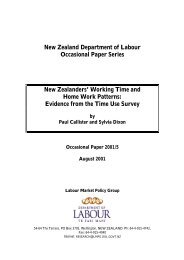

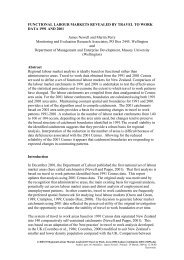

![a note on levels, trends, and some implications [pdf 21 pages, 139KB]](https://img.yumpu.com/27285836/1/184x260/a-note-on-levels-trends-and-some-implications-pdf-21-pages-139kb.jpg?quality=85)


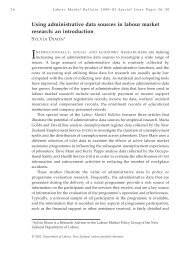
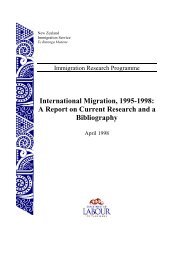
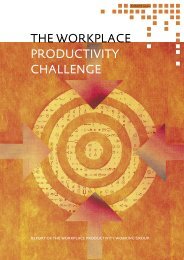
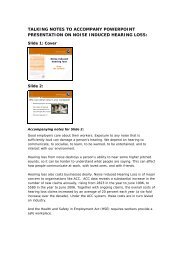
![Labour Market Trends and Outlook - 1996 [pdf 18 pages, 94KB]](https://img.yumpu.com/27285764/1/184x260/labour-market-trends-and-outlook-1996-pdf-18-pages-94kb.jpg?quality=85)

